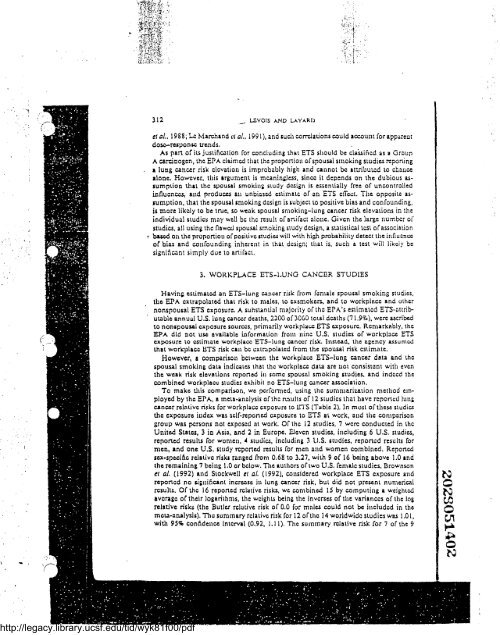ets exposure, lung cancer - Legacy Tobacco Documents Library
ets exposure, lung cancer - Legacy Tobacco Documents Library
ets exposure, lung cancer - Legacy Tobacco Documents Library
You also want an ePaper? Increase the reach of your titles
YUMPU automatically turns print PDFs into web optimized ePapers that Google loves.
http://legacy.library.ucsf.edu/tid/wyk81f00/pdf<br />
312 . LL•VOfS AND t.+.YARt)<br />
er al., 1988 ; Lc Marchand c1 al., 1991), and such corrclations could account for appareuc<br />
dose-responsc trends .<br />
As part of its justiflcation for concluding thrt ETS should be classificd as a Group<br />
A careinogen, the EPA claimed that the proportion of spousal smoking studies reporting<br />
a <strong>lung</strong> <strong>cancer</strong> risk elevation is improbably high and cannot be attributed to chance<br />
alone. However, this argument is meaningless, since it depends on the dubious assumption<br />
that the spousat smokinZ study design is essentially free of uncontrolled<br />
influences, and produces att unbiased estimate of an ETS effcc :t . The opposite assutnption,<br />
that the spousal smoking design is subject to positive bias and confounding,<br />
is more likely to be true, so weak spousal smoking-<strong>lung</strong> <strong>cancer</strong> risk elevations in the<br />
individual studies may well be the result of anifact alotte . Givcn the large number oi'<br />
studies, all using the llawcd spousal smoking study design, a statistical u :sl of association<br />
based on the proportion of positive studies will with high probability detect the influcncc<br />
of bias and confounding inherent in that design ; that is, such a test will likciy be<br />
significant simply due to anifact .<br />
3. WORKPLACE ETS-1 .UNG CANCER STUDIES<br />
Having estimated an ETS-<strong>lung</strong> <strong>cancer</strong> risk from fcmale spousal smoking studies,<br />
the EPA extrapolated that risk to males, to exsmokers, and to workplace and other<br />
nonspousal. ETS <strong>exposure</strong>. A suhstantial majority of thc EPA's estimatcd ETS-attributable<br />
annual U .S . <strong>lung</strong> <strong>cancer</strong> deaths, 2200 of 30G0 total deaths (71 .9So), were ascribed<br />
to nonspousat <strong>exposure</strong> sources, primarily workplace ETS exposurc . Rcmarkably, the<br />
EPA did not use available information front nine U .S, studies of workplace ETS<br />
<strong>exposure</strong> to estimate workplacc ETS-<strong>lung</strong> canccr risk . Instead, the agency axsumcd<br />
that workplace l3TS risk can be axtrapolated from the spousal risk estimate .<br />
However, a comparison bctwcen the workplace BTS-<strong>lung</strong> <strong>cancer</strong> dttta and the<br />
spousal smoking data indicates that the workplacc data are not consistent with even<br />
the weak risk elevations roponed iu some spousal smoking studies, and indeed the<br />
combined workplacc studies exhibit no ETS-<strong>lung</strong> <strong>cancer</strong> association .<br />
To make this comparison, we performed, using the summarization method employed<br />
by the EPA, a meta-analysis of the rt,-sults of 12 studies that have reportcd lutts<br />
caneer relative risks for workplace <strong>exposure</strong> to L•-1'S (Table 2) . In most of these studies<br />
the <strong>exposure</strong> index was sclf-reponed <strong>exposure</strong> to ETS at work, and the comparison<br />
group was porsons not exposed at work . Of the 12 studies, 7 were conducted in the<br />
United States, 3 in Asia, and 2 in Europe . L•levcn studies, including 6 U .S . studies,<br />
reported results for women, 4 studies, including 3 U .S . studies, reportcd results for<br />
men, and one U .S . study rcported results for rncn and women combined . Reported<br />
sex-specific relative risks ranged from 0 .68 to 3 .27, with 9 of 16 being above 1 .0 and<br />
the remaining 7 being 1 .0 or bclow . The authors of two U .S . femalc studies, IIrownson<br />
er al. (1992) and Stockwell er aL (1992), considered workplace ETS oxposure and<br />
reported no sigtti6cant increase in <strong>lung</strong> <strong>cancer</strong> risk, but did not present numerical<br />
results . Of the 16 reponed relative risks, we combined 15 by computing a weighted<br />
average of their logarithms, the wcights being the inverses of the variances of the log<br />
relative risks (the Butler rclutive risk of 0 .0 for males could not be ittcludcd in the<br />
mcta-analysir). The sunttnary relative risk for 12 of the 14 worldwide studies was 1 .01,<br />
with 95% confidence interval (0 .92, 1 .11) . The summary rr,.lative risk for 7 of the 9

















